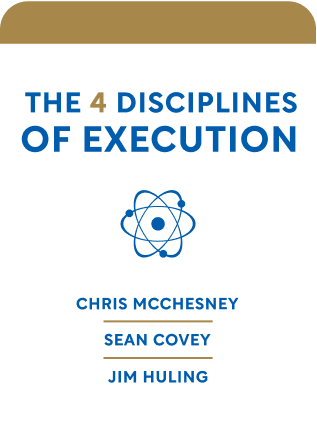

This article is an excerpt from the Shortform book guide to "The 4 Disciplines of Execution" by Chris McChesney, Sean Covey, and Jim Huling. Shortform has the world's best summaries and analyses of books you should be reading.
Like this article? Sign up for a free trial here .
What are the four areas identified in The 4 Disciplines of Execution? How do the four disciplines support executing on a strategy?
The 4 Disciplines of Execution is a book that explains how to actually do the things in the plans. The methodology, known by its shorthand 4DX, includes focus, leverage, engagement, and accountability.
Read more about The 4 Disciplines of Execution and what each discipline requires.
The 4 Disciplines of Execution
How often have you come up with an amazing plan, showed it off, admired it, been sure that it’s the solution to all your problems, only to have it die a slow death over the next few months? This isn’t uncommon—strategy (your beautiful plan) is much easier and better-studied than execution (actually carrying out your plan).
The 4 Disciplines of Execution explains how to actually do the things in the plans. Execution requires behavioral change, which is one of the hardest things to generate, both in yourself, your team members, and your organization. The greatest enemy of execution and behavioral change is the whirlwind—the day-to-day activities necessary to keep an organization running. It’s very difficult to make changes when you’re stuck inside the storm and completely occupied with just trying to keep things running.
The authors have come up with a system called 4DX (4 disciplines of execution). This system makes it possible for organizations to achieve wildly important goals while fending off the whirlwind. It works for any kind of team (e.g. creative, military), in any type of structure (e.g., matrixed), and in any industry (e.g., manufacturing, government). It even works in personal or family settings. Additionally, in the process of achieving a goal, 4DX creates behavioral change that leads to a permanently higher level of performance.
The 4 Disciplines of Execution is not about how to tame the whirlwind; it’s about how to get things done in spite of the whirlwind. You should give 4DX 20% of your time and energy. 80% should remain with the whirlwind. The whirlwind may be an enemy of execution, but that doesn’t mean it’s not important—you need these day-to-day operations to keep an organization running.
What Are the Principles of 4DX?
4DX contains the following four principles: focus, leverage, engagement, and accountability. These principles probably aren’t new to you—in fact, they’re natural laws. (They’ve been affecting you even if you weren’t aware of them until now.) However, the key of 4DX is to apply the principles in a very particular way.
Discipline 1: Focus
In Discipline 1, choose one to three goals to focus on. Call them wildly important goals (WIGs) to remind yourself and your organization that they’re top priority. Choosing so few goals may feel counterintuitive. Do it anyway.
Senior leaders choose the WIG for an organization. Then, each team comes up with supporting WIGs. There are four rules for choosing team WIGs:
- Rule #1: Focus. No team will choose more than two WIGs.
- Rule #2: Team WIGs must directly support the overall WIG.
- Rule #3: Teams get to choose their own WIGs. Senior leaders can veto, but cannot make the final decision.
- Rule #4: All WIGs must be stated in the format “from point A to point B by deadline.”
For example, consider an organization with an overall WIG of “Increase profit from $10 million to $15 million by June 1.” A sales team might come up with a single WIG: “Increase profit from our department from $2 million to $3 million by June 1.”
How do you choose good WIGs? WIGs must be challenging but also attainable. There are four steps to settling on a WIG in The 4 Disciplines of Execution:
- Brainstorm. Ask yourself what kind of change would have the most impact on your organization or team. Consider things that aren’t working, and things that, if they worked even a little better, would have a large impact. Involve peer leaders and your team in the brainstorming.
- Assess. Consider the list of team WIGs you brainstormed. Which ones will have the highest impact on the overall WIG?
- Test. Your WIG must support the overall WIG, be measurable, be driven by the team rather than the leader, and shouldn’t depend more than 20% on another team.
- State. Choose your WIG and write it in the format “from point A to point B by deadline.”
Discipline 2: Leverage
In Discipline 2, you learn how to get from point A to point B. Points A and B are lag measures—results that can’t be changed after they’ve been measured. For example, a lag measure is your body weight on a scale.
To create results, you’re going to need a different type of measure—a lead measure. Lead measures predict and influence lag measures, so when you apply disproportionate energy to lead measures, the lag measures move too. If your lag measure is your weight, the lead measures are how much you eat and exercise. If you want to change your weight, it’s more productive to change your diet and exercise than to weigh yourself multiple times, hoping your weight will have changed since the last time you stepped on a scale.
It may feel counterintuitive to spend a lot of time and energy on a measure that isn’t a result. Do it anyway.
For example, the above team had a WIG of “Increase profit from our department from $2 million to $3 million by June 1.” Their lead measures can be things that increase revenue or reduce costs, such as “each team member must pitch the product to three new clients a week.”
How do you choose good lead measures? There are four steps:
- Brainstorm. Ask yourself what kind of changes would highly affect the WIG. Consider things you’ve never done before, things you could improve, and things you’re doing badly that might hamper you. Look at successful companies’ measures for inspiration. Involve your team in the brainstorming.
- Assess. Consider the list of lead measures you brainstormed. Which ones will have the most effect on the team WIG?
- Test. Your lead measure must be predictive, maintainable, measurable, and impactful. It must have an effect on the team WIG, be driven by the team rather than the leader, and it must be influenceable—your team needs to have control over it, so it shouldn’t depend more than 20% on another team.
- State. The lead measure statements don’t have a strict format like a WIG, but they should still be specific, start with a simple verb, and be concise. They should be clear about expectations—does the lead measure need to be done daily or weekly? How often, how much, and how well? Are they concerned with team or individual performance?
Discipline 3: Engagement
In Discipline 3, engage your team by making 4DX into a game they can win. You already did some engagement work in the previous two disciplines by consulting your team members about the team WIG and lead measures. When people choose their own goals and feel ownership, they’re more engaged. They’re also more engaged when they enter a competition their team can win—humans have a natural urge to compete and love to win.
For example, recall the sales team with the WIG of “Increase profit from our department from $2 million to $3 million by June 1” and the lead measure of “each team member must pitch the product to three new clients a week.” Their scoreboard might have a visual that shows two trend lines, one that goes from $2 million to $3 million (the target), and one that shows their actual profit. They would have a separate visual for their lead measure. It might be a chart where each team member writes down how many pitches they completed that week.
How do you design a good scoreboard? This scoreboard must tell your team if they’re winning (if they’re on track to meet the WIG) and is a constant reminder of the game. There are four steps to creating a scoreboard in The 4 Disciplines of Execution:
- Format. Some options for format are trend line, gauge, bar chart, or andon chart. Your team can personalize the scoreboard however they like—this will engage them further.
- Test. The scoreboard design must be simple, visible, complete, and easy to read. It must show a target line—where the team is (current progress), and where they need to be (WIG and lead measure target).
- Create. Ideally, ask your team to physically build the board themselves. Materials don’t matter—they can choose to use posterboard or do a digital version, whatever they like as long as it meets the criteria in the test step.
- Update. The board must be updated at least weekly. Choose a scorekeeper (or more than one) and make sure everyone knows when and how often the board will be updated.
Discipline 4: Accountability
In Discipline 4, run a weekly accountability meeting called a WIG session. Because achieving the WIG is now a game, people are accountable to their teammates as well as the boss. When people know others are depending on them, they’re more motivated and engaged, they try harder, and performance becomes a matter of personal pride.
The WIG session takes place at least once a week, lasts less than 30 minutes, and has a very specific agenda: review the scoreboard, report on last week’s commitments (and celebrate them), and come up with new commitments. The whirlwind is not allowed anywhere near the WIG session. The regularity of sessions and mandatory attendance are key to this discipline—accountability requires consistency.
WIG session commitments must directly influence the WIG by influencing the lead measures (no whirlwind commitments). They must be focused, specific, impactful, and not take longer than a week to achieve. The person who makes the commitment must be able to do most of the work themselves.
Leaders make weekly commitments too. The most effective commitments for leaders are ones that “clear the path” and ones that help their team achieve their individual commitments and improve their execution. For example, if a team member requires a new piece of software, a leader could secure approval for the purchase.

———End of Preview———
Like what you just read? Read the rest of the world's best book summary and analysis of Chris McChesney, Sean Covey, and Jim Huling's "The 4 Disciplines of Execution" at Shortform .
Here's what you'll find in our full The 4 Disciplines of Execution summary :
- The 4 disciplines that can make any strategy a successful reality
- Why a great plan falls apart when you don't think adequately about execution
- The 6 steps you need to scale the 4DX model across an entire organization






